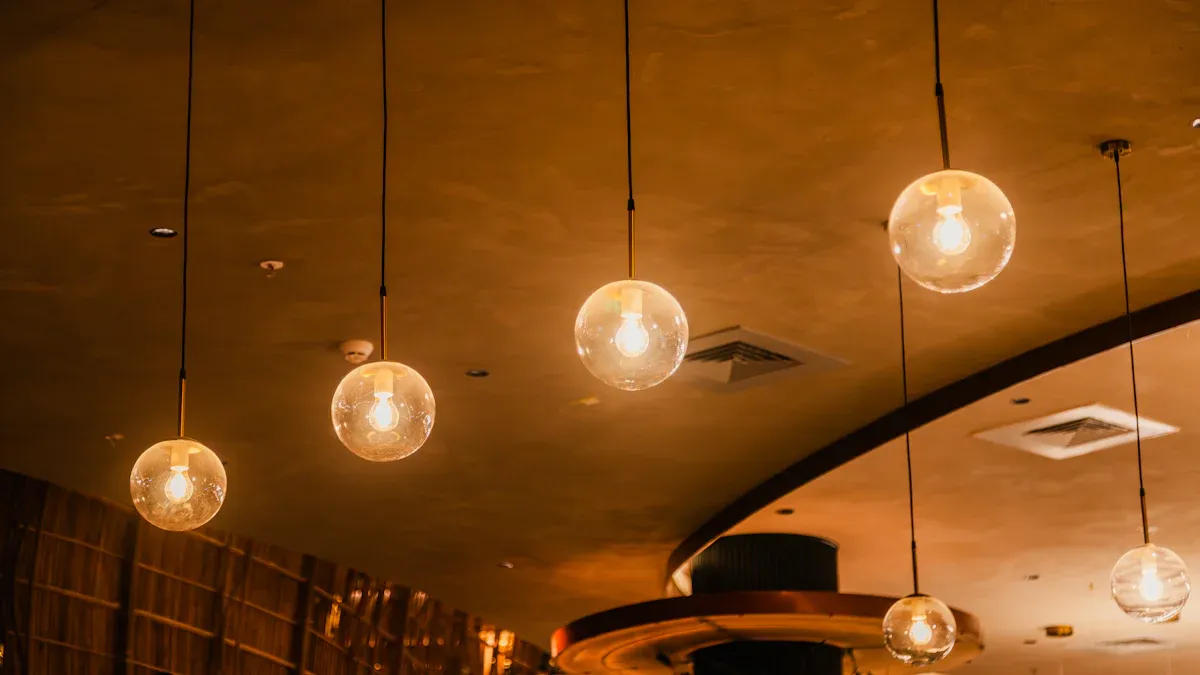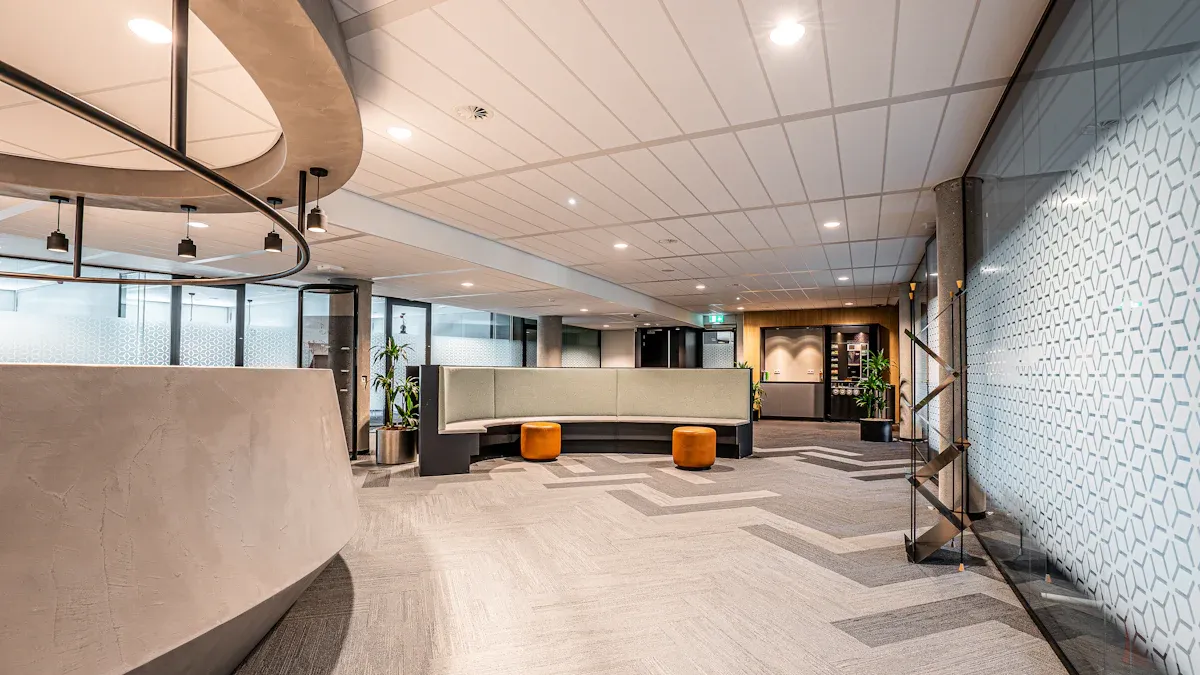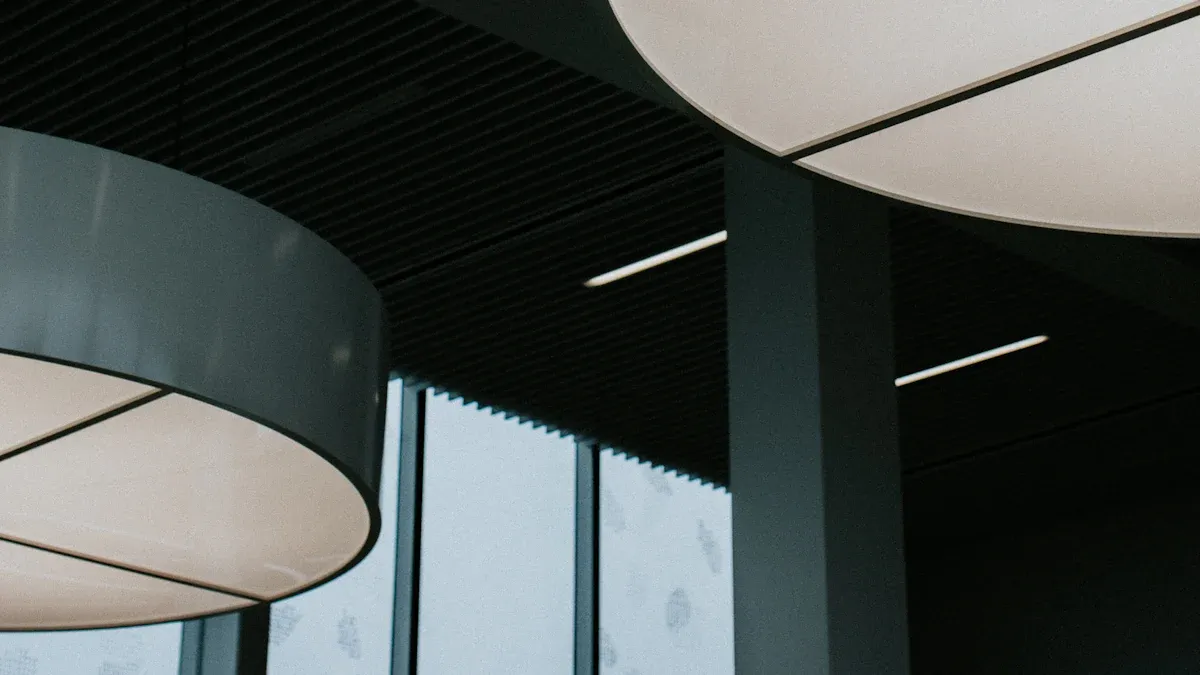How Modern Commercial Lighting Systems Are Transforming Business Environments

Modern commercial lighting is transforming how companies operate with smarter ideas. These systems utilize new technology like LED lights, which consume less power. For instance, modern LED lights now provide over 100 lumens per watt, significantly reducing energy bills. Additionally, solar street lights are gaining popularity for outdoor areas, as they save energy and contribute to environmental sustainability.
Incorporating these modern commercial lighting solutions can enhance workplaces for employees. Smart designs and controls adapt to your needs, improving the functionality of spaces and creating a positive atmosphere. These advancements not only save money but also benefit the environment.
Key Takeaways
New LED lights can cut energy bills by 80% compared to old bulbs.
Smart lights have sensors to change brightness, saving 60% energy and working better.
Using green materials in lights lowers trash and helps the planet.
Sunlight in offices makes workers happier and work better, creating nicer spaces.
Spending on new lights saves money over time and helps nature.
Energy Efficiency and Sustainability

LED Technology and Energy Savings
Using LED lighting can cut down energy use a lot. LEDs need about 80% less energy than old incandescent bulbs. For example, a 60W bulb uses 60 kWh in 1,000 hours. A 12W LED bulb only uses 12 kWh for the same time. This means over 80% savings on electricity bills.
Factor | LED Lighting | Traditional Lighting |
|---|---|---|
Energy Efficiency | ~100 lumens/watt | 10–20 lumens/watt |
Energy Cost Savings | Up to 80% lower costs | Higher ongoing energy costs |
Lifespan | 50,000+ hours | 1,000–2,000 hours |
Environmental Impact | Eco-friendly, lower CO2 | Larger carbon footprint |
Some U.S. areas offer rebates for LED upgrades, covering 35%-50% of costs. Tax credits of $0.60 per square foot may also help, making LEDs cheaper to install.
Eco-Friendly Materials in Lighting
Modern lighting often uses materials that are better for the planet. Companies now use recycled metals, bamboo, and renewable resources for eco-friendly designs. These materials cut waste and support sustainability goals. Smart lighting also lasts longer, creating less trash.
Choosing lights made from biodegradable or recyclable materials helps the environment. For instance, new ceiling lamps now use sustainable materials, which eco-friendly buyers like.
Reducing Operational Costs with Efficient Lighting
Efficient lighting saves energy and lowers business costs. LEDs last a very long time, so you don’t replace them often. This reduces maintenance work and downtime.
Metric | LED Linear High Bay Lights | Traditional Lighting Solutions |
|---|---|---|
Energy Efficiency | 120-150 lm/W | Lower than 120 lm/W |
Lifespan | Tens of thousands of hours | Shorter lifespan |
Maintenance Frequency | Less frequent | More frequent |
Environmental Impact | No harmful substances | May contain mercury |
A study by Sun Bright LED Systems LLC showed a business saved $900 monthly after switching to LEDs. This proves modern lighting can save money and improve efficiency.
Smart and Adaptive Lighting Systems
Modern business lighting now includes smart systems for better use. These systems use advanced technology to meet changing business needs.
IoT Integration for Smarter Lighting
The Internet of Things (IoT) has changed how lights work. IoT lighting collects data and adjusts settings in real-time. For example:
A smart highway lighting system used IoT to check traffic. It changed brightness to save energy and improve safety.
In rural areas, solar lights with motion sensors adjusted schedules. This saved power and helped the environment.
These examples show how IoT makes lighting smarter and more efficient.
Automation and Remote Control Features
Automation and remote controls make managing lights easy. Automated lights sense people, adjust to sunlight, and follow user settings. Studies say these features cut electricity use by up to 60%. Savings include:
24% from motion sensors.
28% from sunlight adjustments.
31% from personal settings.
36% from group settings.
38% from combining all methods.
With remote controls, you can change lights from anywhere to save energy.
Customizable Lighting for Business Needs
Custom lighting fits specific business needs. It improves safety and works better for different spaces. For example:
Waterproof and explosion-proof lights are key for factories and mines.
Custom designs match business branding and goals.
Working with lighting experts ensures the best solutions for your needs. Modern lighting is a great tool for any business.
Measure | Description |
|---|---|
Big energy cuts from smart features like dimming and motion sensors. | |
Cost Savings | Lower bills and fewer operating costs. |
CO2 Emissions Reduction | Can cut CO2 emissions in half, helping the planet. |
Payback Period | Smart lighting pays for itself in just a few years. |
Net Present Value (NPV) | Positive NPV shows gains of up to €500 over ten years. |
Internal Rate of Return (IRR) | High IRR proves smart lighting is a good investment. |
Smart lighting improves efficiency and saves money while helping the environment.
Human-Centric and Biophilic Lighting

Modern lighting now focuses on employee health and natural designs. These styles aim to make workplaces better by using nature-inspired ideas.
Helping Employees Work Better with Lighting
Lighting affects how well people work. Natural light boosts mood, lowers stress, and helps thinking. Workers with natural light feel happier and miss fewer days. Bright white or blue lights (4000-6500K) help with focus. Warm lights (2700-3500K) create a calm space for teamwork.
A study found natural light makes workers more engaged and productive. Another study showed nature-inspired offices increase creativity by 15%.
Improving Health with Smart Lighting
Health-focused lighting can make people feel better. Special heat maps show how light affects your body’s daily cycles. Good lighting reduces eye strain, headaches, and tiredness. Research shows natural light improves mood and lowers discomfort.
Evidence Type | Details |
|---|---|
Circadian Heat Map | Tracks how light supports your body’s natural rhythms. |
Performance Measurement | Tests how lights help health and comfort. |
Algorithms Used | Calculates scores to meet health rules. |
Using health-friendly lighting creates a workspace that helps both body and mind.
Using Sunlight for Better Workplaces
Sunlight is key to nature-inspired designs. It helps people sleep better, which boosts work performance. A study found workers with sunlight sleep more and work better. Another survey said 72% of employees want sunlight at work.
Adding big windows, skylights, or mirrors increases sunlight indoors. This saves energy and makes spaces brighter and more welcoming.
By using human-focused and nature-inspired lighting, workplaces can be healthier, more productive, and eco-friendly.
Design and Aesthetic Impact
Boosting Brand Identity with Lighting
Lighting helps show what your brand is all about. Modern lighting can create a special look for your business. For example, fancy lights can show your brand’s style. A boutique might use shiny chandeliers to feel fancy. A tech store might pick cool, modern lights to look high-tech.
Good lighting also makes important spots, like displays or signs, stand out. This makes your space look better and grabs attention in a busy market. Matching your lighting to your brand’s message helps customers remember you.
Setting the Mood in Business Spaces
The right lighting changes how a space feels. Bright lights make places feel happy and full of energy, great for stores or gyms. Soft, warm lights make spaces feel cozy, perfect for cafes or restaurants.
New lighting lets you change the mood for events or times of day. Smart bulbs let you switch from bright daytime lights to calm evening lights easily. This keeps your space comfy and fun for visitors all the time.
Mixing Style with Usefulness
Modern lighting looks good and works well too. Soft lights make people stay longer, while bright lights add energy. Smart systems save power and adjust to different needs.
Decorative lights make spaces look fancy and attract customers. For example, a store might use hanging lights to look stylish and useful. By mixing beauty with function, you can make a space that looks great and works well.
Future Trends and Innovations in Modern Commercial Lighting
New Technologies Changing Lighting
The future of lighting is changing with amazing new ideas. These include:
Li-Fi: This uses light to send data faster than Wi-Fi. Its market could grow from $1.72 billion in 2024 to $19.79 billion by 2029, with a huge growth rate of 62.90%.
OLED Lighting: This type of lighting saves energy and is flexible in design. It may grow by over 14% yearly from 2021 to 2026.
Smart Lighting Systems: These use AI and IoT to save energy and improve user experience. They can cut energy use by up to 85%.
Human-Centric Lighting: This lighting matches natural body rhythms, helping people feel better and work smarter.
Smart City Projects: Advanced lights now help manage traffic and monitor the environment in cities.
These ideas are not just dreams—they are already making lighting smarter and better.
Problems with Using New Lighting
Even with benefits, using advanced lights has problems. High setup costs stop some businesses, especially in places where price matters. Different brands and systems don’t always work well together. Managing smart lights needs special software, which can feel hard to use.
Many people don’t know enough about these systems, making it harder to switch from old lights. Teaching people, creating standards, and offering cheaper options will help more businesses use modern lighting.
What’s Next for Lighting Systems
Big changes are coming to commercial lighting. By 2025, better LEDs and smart controls could cut global lighting energy use by 20% compared to 2020. Experts think advanced lighting will lead the market by 2030, thanks to more money spent on IoT research.
Top companies are already focusing on new ideas. For example, Acuity Brands saw a 35% rise in sales of smart lighting products. Legrand reported a 34% increase in connected devices. These trends show a strong move toward smarter, greener lighting for the future.
Modern business lighting has changed workplaces by saving energy and improving conditions. These systems use smart technology to save power and last longer. For example:
Eco-friendly lights make LEDs work for more years.
Solar power helps cut harmful emissions.
Companies using these lights see real benefits. Workers have less eye strain, think better, and get more done. Research shows LEDs use 80–90% less energy and can last 50,000 hours. This lowers costs and helps the planet.
Using these new ideas makes businesses more efficient and eco-friendly. Modern lighting helps companies stay successful and ready for future changes.
FAQ
What are the main benefits of modern commercial lighting systems?
Modern lighting saves energy, lowers costs, and boosts productivity. It uses eco-friendly materials and smart tech like LEDs and IoT. These systems make workplaces healthier and more flexible for everyone.
How does smart lighting save energy?
Smart lights use sensors and automation to adjust brightness. They dim or turn off when rooms are empty or sunlight is enough. This stops wasting energy and saves money.
Are modern lighting systems expensive to install?
They cost more at first than old systems. But rebates, tax credits, and energy savings make them worth it. LEDs last longer and use less power, cutting costs over time.
Can modern lighting improve employee well-being?
Yes, special lighting helps natural body rhythms and reduces eye strain. It improves mood, focus, and energy. Adding sunlight or adjustable lights makes workspaces healthier and more comfy.
What is Li-Fi, and how does it relate to lighting?
Li-Fi sends data using light waves, faster than Wi-Fi. It lights up spaces while transferring data securely. This makes it a smart, two-in-one solution for businesses.
See Also
Effective Commercial Lighting Strategies for Business Success
Modern LED Highway Lighting: Enhancing Safety and Efficiency
Benefits of LED Street Bulbs: Efficiency and Longevity Explained
Understanding ROI and Costs of Commercial LED Lighting
Choosing Outdoor LED Lighting: Types, Benefits, and Installation Advice

